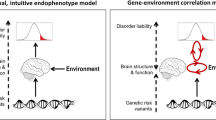Abstract
Conclusions about the genetic architecture of a phenotype relating to the contributions of genetic additivity, dominance, epistasis or genotype × environment interaction, depend upon the statistical and distributional properties of the measured trait. This dependence is frequently ignored in contemporary genetic studies and can radically change the conclusions that may be drawn from the data. The interdependence of the conclusions about genetic architecture and instruments used for behavioral measurement is explored by simulated studies of the interaction between candidate genes and measured environment in psychiatric genetics. Trait values are simulated (N = 100,000) under several commonly encountered scenarios and subjected to two simulated 20-item psychological tests each comprising items with different patterns of difficulty and sensitivity to variation (discriminating power) in the latent trait. Test scores are generated for each test by summing the binary responses across all items. The full model for digenic additive and non-additive genetic effects and G × E is fitted to the trait values and test scores under a range of different simulated genetic architectures. Untransformed test scores show complex patterns of epistasis and G × E even when the underlying effects of genes and environment are purely additive and the transformation of symptom counts does not fully recover the simulated underlying genetic architecture. Accordingly, failing to allow for the theory of measurement when analyzing details of genetic architecture may frequently lead to replicable over-reporting of interactions and mislead potential investigators and funding agencies.
Similar content being viewed by others
References
Bartlett MS (1947) The use of transformations. Biometrics 3:39–52
Bucio-Alanis L, Hill J (1966) Environmental and genotype-environmental components of variability II. Heterozygotes. Heredity 21:115–127
Eaves LJ (2014) Genotype × environment interaction in psychiatric genetics: deep truth or thin ice? Psychol Med. (in press)
Eaves LJ, Eysenck HJ (1977) A genotype-environmental model for psychoticism. Adv Behav Res Ther 1:5–26
Fisher RA, Immer FR, Tedin O (1932) The genetical interpretation of statistics of the third degree in the study of quantitative inheritance. Genetics 17:107–124
Jinks JL, Fulker DW (1970) Comparison of the biometrical genetical, MAVA and classical approaches to the analysis of human behavior. Psychol Bull 73:311–349
Loehlin JC (1965) Some methodological problems in Cattell’s multiple abstract variance analysis. Psychol Rev 72:156–161
Mather K (1966) Variability and selection. Proc Roy Soc Lond B 164:328–340
Mather K (1974) Non-allelic interaction in continuous variation of randomly breeding populations. Heredity 32:414–419
Mather K, Jinks JL (1982) Biometrical genetics, the study of continuous variation, 3rd edn. Chapman and Hall, London
Miko I (2008) Epistasis: gene interaction and phenotype effects. Nat Educ 1:197
Purcell S (2002) Variance components models for gene–environment interaction in twin analysis. Twin Res 5:554–571
Van der Veen JH (1959) Tests of non-allelic interaction and linkage for quantitative characters in generations derived from two diploid pure lines. Genetica 30:201–232
Wray NR, Coventry WL, James MR, Montgomery GW, Eaves LJ, Martin NG (2008) Use of monozygotic twins to investigate the relationship between 5HTTLPR genotype, depression and stressful life events: an application of item response theory. Novartis Found Symp 293:48–59
Acknowledgments
We are indebted to John Loehlin for his career of exemplary and critical scholarship that help generations of students realize that truth is not always what it seems. The age difference between the authors of this MS requires that the personal recollections in the first paragraphs are those of the first author alone. LJE is supported by grant R01AA5130267 from the National Institutes of Health (PI KS Kendler). We thank Nick Martin for suggesting this line of inquiry and Mike Neale for nuanced discussion of the implications of G × E and measurement for psychiatric genetics. Many of his thoughtful suggestions are not reflected in the current manuscript and warrant further inquiry.
Conflict of Interest
There are no conflicting interests to declare.
Human and Animal Rights and Informed Consent
This article does not contain any studies with human or animal subjects performed by any of the authors.
Author information
Authors and Affiliations
Corresponding author
Rights and permissions
About this article
Cite this article
Eaves, L., Verhulst, B. Problems and Pit-Falls in Testing for G × E and Epistasis in Candidate Gene Studies of Human Behavior. Behav Genet 44, 578–590 (2014). https://doi.org/10.1007/s10519-014-9674-6
Received:
Accepted:
Published:
Issue Date:
DOI: https://doi.org/10.1007/s10519-014-9674-6




